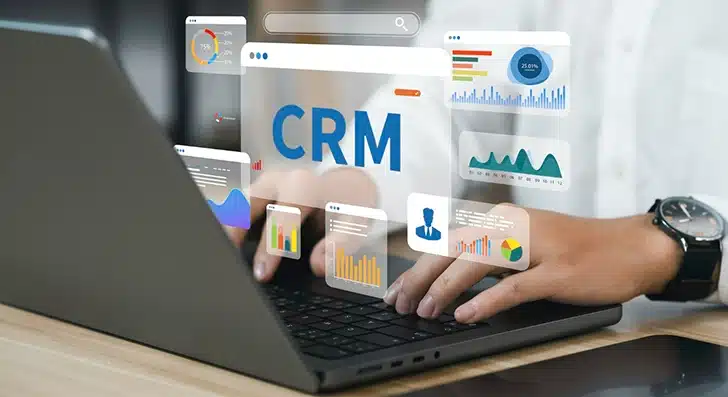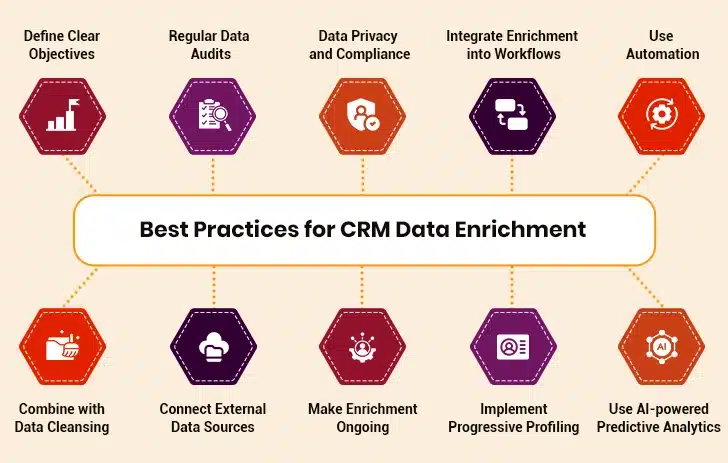When it comes to converting leads into sales, having the right information at the right time can make all the difference. Think of your CRM system like a map that helps you navigate through potential customers. But what if this map is incomplete or outdated? That’s where CRM data enrichment comes in, transforming static databases to dynamic intelligence hubs. It’s like updating your map with new roads, landmarks, and details that help you reach your destination with ease.
By enriching your CRM data, you get a clearer picture of who your leads are and what they need. This helps you score leads more accurately, focusing on the ones most likely to become customers. It also means your sales team can have more meaningful conversations, addressing the specific challenges and interests of each lead. This not only boosts your sales conversions but also enhances the overall customer experience. In this detailed post, we will explore the overview of CRM data enrichment and the key challenges of lead scoring without data enrichment. It also explains how enriching CRM data improves lead scoring and sales conversion. Furthermore, the post delves into the tools and best practices for B2B CRM data enrichment.

Table of Contents
A Quick Overview of CRM Data Enrichment
Key Data Attributes That Can be Enriched
Key Difference Between Data Cleansing, Data Enrichment, and Data Augmentation
Key Challenges of Lead Scoring Without Data Enrichment
How Enriching CRM Data Improves Lead Scoring and Sales Conversion
How CRM Data Enrichment Helps Sales Development Reps and Account Executives Close Deals Faster
Best Tools for B2B CRM Data Enrichment
A Quick Overview of CRM Data Enrichment
CRM data enrichment means adding more useful details to your customer information. Imagine your customer list has basic details like names and phone numbers. Enrichment adds missing pieces and updates old info automatically. It fills in job titles, company details, social media links, and buying habits. This helps businesses know their customers better without manual research. For example, if you only have an email, enrichment can add the person’s job role and company size. Cleaner, complete data means you can send more relevant messages and improve sales. It’s like upgrading your contacts from a basic notebook to a smart organizer that keeps itself updated.
Key Data Attributes That Can be Enriched
1. Firmographics Enrichment
This means adding details about companies, like their size, location and industry. It helps businesses understand which companies to work with.
2. Demographics Enrichment
This is about adding personal info like age and income about customers. Stores use this to offer products people actually want.
3. Technographics Enrichment
This means learning about the technology people use like their phones, apps and websites. Tech companies use this to make better products.
4. Behavioral Enrichment
This studies how people behave like what they buy and browse. Stores use it to guess what customers might want next.
Key Difference Between Data Cleansing, Data Enrichment, and Data Augmentation
Given below is a table that clearly outlines the key differences between data cleansing, data enrichment, and data augmentation. Let’s understand!
| Aspect | Data Cleansing | Data Enrichment | Data Augmentation |
|---|---|---|---|
| Purpose | Focuses on fixing errors and removing inconsistencies in existing data to improve accuracy and reliability. | Adds missing or supplemental information to make data complete and insightful. | Expands datasets by adding entirely new data points or features to enhance usability. |
| Process | Removes duplicates, outdated records, and incorrect entries within the dataset. | Appends external data like demographics or contact details to fill gaps in existing records. | Combines internal and external datasets to create richer, more diverse datasets. |
| Goal | Ensures the database is clean, accurate, and ready for use. | Enhances the depth of information for better decision-making and targeting. | Broadens the scope of data to uncover new patterns and insights. |
| Timing | Typically performed first to prepare data for further processes. | Done after cleansing to enrich clean data with additional details. | Can be performed independently or alongside enrichment for advanced analysis. |
| Examples | Removing duplicate customer profiles or fixing incorrect email addresses. | Adding social media profiles or geographic details to customer records. | Integrating behavioral data with existing CRM records for deeper insights. |
| Outcome | Produces a trustworthy dataset free from errors or irrelevant entries. | Provides a complete and actionable dataset with enriched context. | Creates larger datasets that enable predictive modeling and trend analysis. |
Key Challenges of Lead Scoring Without Data Enrichment
Without B2B data enrichment, lead scoring may face several challenges. Deep dive to take a more detailed look at some of the common lead scoring challenges that you may encounter.
1. Inaccurate Lead Qualification
a. Overreliance on Manual Inputs
Lead scoring without data enrichment often relies too heavily on manual inputs. This may lead to inaccurate lead qualification since it misses critical indicators of purchase intent.
b. Lack of Behavioral Data
Behavioral data reveals how leads show interest in your brand through their actions. Without this data, you might overlook high-intent buyers that are researching your company.
2. Limited Data Points
a. Insufficient Variables for Analysis
Lead scoring models require a variety of data points to predict lead quality accurately. Without B2B data enrichment, you might have too few variables. This may limit the model’s ability to generate accurate predictions. Henceforth, it leads to misqualified leads and inefficient sales processes.
b. Data in Silos
When data is stored across systems, it’s tricky to get a complete view of the customer. This common lead scoring mistake prevents the effective integration of demographic and behavioral data for lead scoring.
3. Data Quality Issues
a. Low Data Quality
Poor data quality can significantly compromise the accuracy of lead scoring models. Inconsistent or missing data can lead to incorrect assessments of lead potential.
b. Incomplete or Outdated Data
Without enrichment, data might be incomplete and lack essential lead information. This may result in inefficient resource allocation.
4. Missed Opportunities
a. High-Quality Leads Overlooked
Without comprehensive data, convertible leads might be overlooked. It means potential customers who are ready to buy might not receive the attention they deserve. This may lead to missed sales opportunities.
b. Low-Quality Leads Prioritized
Conversely, low-quality leads might be prioritized if they fit certain demographic criteria but lack actual buying intent. This wastes time and resources on leads that are unlikely to convert.
5. Alignment with Sales Goals
a. Lack of Teamwork
Lead scoring models developed without seeking inputs from the sales team may not align with the defined goals. When unqualified leads reach sales, it is likely to cause inefficiencies and frustration.
b. Outdated Models
If lead scoring models aren’t regularly updated, they may become ineffective. This may lead to misaligned efforts for high-quality leads.
6. Predictive Model Limitations
a. Limited Predictive Power
Without enriched data, predictive lead scoring models lack the depth of information needed to predict buying behavior accurately. This limits their ability to identify high-intent buyers effectively.
b. Dependence on Static Data
Models might rely too heavily on static data, which may not reflect changing customer behaviors. This may lead to poor lead prioritization.
Data Enhancement vs. Data Enrichment
How Enriching CRM Data Improves Lead Scoring and Sales Conversion
Explore how enriching your CRM data can help you transform your lead scoring and sales conversion strategy, making it more targeted and successful.
I. Accurate Lead Prioritization
Enriched CRM data helps focus on leads that are likely to convert. This ensures that highly relevant leads receive timely attention.
Here are five ways for lead prioritization:
- Prioritize leads based on their conversion potential
- Ensure high-quality leads get timely attention for better conversion rates
- Optimize resources on high-potential leads
- Reduce efforts on low-quality leads to save resources
- Increase conversion rates through accurate prioritization
II. Targeted Outreach
Enriched CRM data supports outreach efforts by providing data into customer behaviors. This increases conversion chances.
Listed below are five ways for targeted outreach:
- Create messages that resonate with leads based on their interests
- Use behavioral data to tailor outreach sequences
- Increase engagement through personalized interactions
- Build trust with leads through relevant communication
- Gain rich insights into customer needs and preferences
III. More Accurate and Dynamic Lead Profiles
Enriching CRM data creates more accurate and dynamic lead profiles. This means having an accurate and complete view of each lead, helping make better decisions.
Here are five ways to have more accurate lead profiles:
- Regularly update profiles to reflect changes in lead information
- Add behavioral data from interactions like emails and chats
- Use predictive analytics to forecast lead behavior
- Integrate social media insights to understand customer interests
- Use external data sources like LinkedIn to add professional details
IV. Better Customer Experiences
Enriched CRM data allows for personalized engagements, leading to higher customer satisfaction. This enhances overall customer experiences.
Let’s explore five ways to offer better customer experiences:
- Provide tailored support based on enriched data
- Build lasting customer relationships through trust
- Encourage positive word-of-mouth referrals
- Increase customer satisfaction through personalized experiences
- Enhance customer loyalty with relevant communications
V. Enhanced Customer Segmentation
Enriched CRM data enables better customer segmentation for targeted marketing. This increases conversion chances by tailoring messages to specific groups.
Below mentioned are five ways for better customer segmentation:
- Segment based on customer behavior for targeted engagement
- Create messages that resonate with each segment
- Design campaigns tailored to specific audience needs and interests
- Increase conversions through targeted engagement
- Deliver personalized offers and communications
VI. Reduce Churn
Spotting unhappy customers early on helps reduce churn. When you notice signs like fewer logins or slower replies, you can reach out to fix issues before they leave. Good CRM data shows these warning signals clearly so you can act fast.
Follow these proven methods to reduce churn:
- Track how often customers use your product
- Notice when they stop opening your emails
- Check if they’re using fewer features than before
- Watch for delayed payments or smaller orders
- Ask for feedback when you see changes in their activity
How CRM Data Enrichment Helps Sales Development Reps and Account Executives Close Deals Faster
Enriched CRM data gives sales teams the right information to work smarter. For sales reps, it shows which leads are most ready to buy, so they focus on the best opportunities first. For account executives, it provides customer details like budget, needs, and past talks, helping them personalize pitches better. With complete, up-to-date info, both teams spend less time searching and more time selling. They can spot when leads are interested and move deals forward faster.
Best Tools for B2B CRM Data Enrichment
For enriching CRM data, there is a wide range of tools out there. Listed below are some popular tools along with their pros and cons. Explore them to choose the right one for your business.
1. ZoomInfo
ZoomInfo is a comprehensive B2B data platform with extensive coverage in North America. The tool offers flexible workflows to keep CRM data up to date. It has real-time, on-demand, and scheduled enrichment options for better customer targeting.
| ZoomInfo Pros | ZoomInfo Cons |
|---|---|
| Flexible enrichment options | Pricing not publicly disclosed |
| Advanced technographics insights | May require significant investment |
| Improves data quality | Limited support for non-B2B data |
| Enhances customer targeting | Requires integration setup |
| Integrates with major CRMs | Limited free trial |
| Data health scanning tools | Not suitable for small budgets |
2. Clearbit (Breeze Intelligence)
Clearbit offers real-time data enrichment for CRM from over 250 sources. It provides accurate and latest information for targeted outreach and integrates well with popular CRMs. Clearbit is useful for enhancing marketing efforts with job change alerts.
| Clearbit Pros | Clearbit Cons |
|---|---|
| Access to many data sources | Limited free access to features |
| Provides accurate, current data | May require technical setup |
| Improves customer targeting | Pricing not publicly disclosed |
| Real-time notifications | Not suitable for non-B2B data |
| Enhances marketing efforts | Limited support for small teams |
| Smooth CRM integration | Can be expensive for small businesses |
3. Lusha
Lusha is a data enrichment tool that provides reliable contact information. It offers a chrome extension for easy LinkedIn data enrichment.
| Lusha Pros | Lusha Cons |
|---|---|
| Easy LinkedIn integration | Limited integration options |
| GDPR compliant | Limited to contact information |
| Automated workflows | Not suitable for small budgets |
| User-friendly interface | Pricing may be high for large teams |
| Reliable contact data | Limited free trial |
| Improves data quality | Limited support for non-B2B data |
4. LinkedIn Sales Navigator
It is a powerful tool for enriching CRM data with professional insights. The tool is ideal for sales teams looking to target the right contacts.
| LinkedIn Sales Navigator Pros | LinkedIn Sales Navigator Cons |
|---|---|
| Enhances sales targeting | Requires LinkedIn subscription |
| Integrates with LinkedIn data | Limited to LinkedIn data |
| Improves sales outreach | May not integrate with all CRMs |
| Provides professional insights | Pricing can be high for large teams |
| Identifies key decision-makers | Not suitable for non-B2B data |
| Real-time job change updates | Limited free trial |
5. Apollo.io
Apollo.io is a reasonable data enrichment tool that updates CRM data in real time. It offers lead scoring and easy CRM integration, making it suitable for small to medium-sized teams.
| Apollo.io Pros | Apollo.io Cons |
|---|---|
| Large contact database | Lacks advanced analytics |
| Data health monitoring | Limited mobile/export credits |
| Improves data quality | Not suitable for large-scale enrichment |
| Great for small teams | Limited free trial |
| Fast data updates | Limited integration options |
| Cost-effective plans | Limited support for non-B2B data |
6. Clay
Clay is a CRM enrichment platform that integrates with multiple data sources. It uses AI-powered workflows for efficient data enrichment.
| Clay Pros | Clay Cons |
|---|---|
| AI-powered enrichment workflows | Requires subscription for full features |
| Easy to use interface | Limited support for non-CRM integrations |
| High data accuracy | Pricing can be expensive |
| Scalable for large datasets | Steep learning curve |
| Outreach automation features | Limited free credits |
7. Cognism
Cognism is a sales intelligence platform that continuously updates CRM data. It offers instant, scheduled, and on-demand enrichment options. Cognism integrates well with Salesforce and other CRMs.
| Cognism Pros | Cognism Cons |
|---|---|
| Centralized field mapping | Custom pricing may be costly |
| Flexible data export options | Not suitable for non-B2B data |
| Improves data accuracy | May require technical support |
| Great for small teams | Limited support for non-sales teams |
| Highly accurate and timely data | Limited free trial |
| Enhances CRM performance | Limited availability in some regions |
8. Kaspr
Kaspr is a B2B data platform that integrates with Salesforce to enrich contact information. It allows enrichment from LinkedIn, CSV uploads, or automated workflows. Kaspr is strong in the European market with a large database.
| Kaspr Pros | Kaspr Cons |
|---|---|
| Bulk CSV enrichment | Limited to B2B data |
| Automated workflows | Mainly focused on Europe |
| Easy LinkedIn integration | Limited free credits |
| Accurate European database | Requires subscription for full features |
| User-friendly interface | May require technical support |
| Cost-effective plans | Limited support for other CRMs |
Understanding the Role of B2B Data Enrichment in Account-Based Marketing
Data Enrichment for CRM: Best Practices for Success
Knowing how to carry out the B2B CRM data enrichment process can make all the difference. Here are some of the best practices you may follow religiously to enrich your CRM data. Following these practices ensures that you have accurate and reliable data.

I. Define Clear Objectives
Start by defining clear objectives for CRM data enrichment. This helps focus on the right data points to achieve your goals. Clear goals guide your enrichment strategy and ensure you’re using relevant data.
II. Regular Data Audits
Regular audits play a critical role in enriching CRM data. These audits help identify mistakes and ensure data quality. This improves customer experiences and decision-making acumen.
III. Data Privacy and Compliance
Data privacy and compliance adherence are crucial for enriching CRM data. Protect customer data privacy and align data enrichment processes with industry compliance, such as GDPR, CCPA, etc. Clearly communicate how data will be used and obtain necessary permissions. Ethical practices build trust and reduce legal risks.
IV. Integrate Enrichment into Workflows
Integrate enrichment into all workflows to identify cross-selling opportunities and enhance customer experiences. This maximizes CRM benefits and drives revenue growth.
V. Use Automation
Using automation can help you in CRM data enrichment. Automation tools collect and analyze data from disparate sources. This saves time and provides rich insights into unique customer needs. This allows companies to respond faster to changing demands.
VI. Combine with Data Cleansing
There is no sense in enriching data that is not relevant. Combine enrichment with data cleansing to eliminate errors and removing irrelevant data. This helps ensure data accuracy and reliability.
VII. Connect External Data Sources
Choose accurate and relevant external data sources to enrich your CRM. This could include third-party databases, social media platforms, market intelligence tools, customer interactions, and real-time data APIs. Using trustworthy data ensures that your enrichment efforts are effective and actionable.
VIII. Make Enrichment Ongoing
Make data enrichment an ongoing process to keep CRM data accurate. Regular updates ensure data remains relevant and actionable.
IX. Implement Progressive Profiling
Progressive profiling is another effective strategy for CRM data enrichment. Instead of asking customers for extensive information at once, you gradually collect more data at various touchpoints. This approach maintains a positive user experience while gradually enriching your data.
X. Use AI-powered Predictive Analytics
Use AI analytics for data enrichment. It helps analyze large datasets, identify hidden patterns, and predict missing information. This enhances data accuracy and relevance.
Summing Up
CRM data enrichment is a powerful technique for improving lead scoring accuracy and sales growth. It helps you focus on the leads most likely to become customers, making your sales efforts more efficient. Enriched data also allows you to tailor your approach to each lead, increasing the chances of successful conversions. It helps you avoid wasting time on incorrect or outdated information, ensuring that your sales team targets the right people at the right time. If you also want to achieve better results in both lead scoring and sales conversions, you may seek CRM data enrichment services from a reliable partner.





